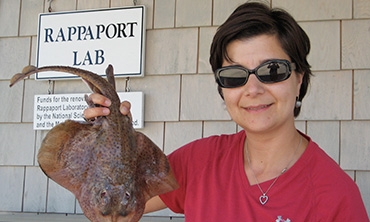Skates have primitive colons. This may not sound like a big deal, but it is. The discovery could change scientific understanding of evolution, of how animals emerged from water to live on land.
Nicole Theodosiou, associate professor of biology, uses these skates, cartilaginous fish related to sharks and rays, to learn how we came to have colons.
“I’m particularly interested in how land animals stay hydrated, even though we don’t have a hard shell that prevents us drying up like raisins in the sun,” she said. “The colon is an important organ that helps us retain and absorb water, but how exactly did we come to have this organ?
The skate has begun to provide an answer.
As a marine creature that hasn’t changed in 450 million years, the skate is a living fossil that provides a snapshot of what animals were like a very long time ago. It’s also a fish that’s isotonic with its environment, meaning concentrations of things like salt inside its body are in exact balance with concentrations outside its body (in the ocean it lives in).
As a result, the skate is never thirsty or in danger of not getting enough to drink. But – intriguingly – it does have a rudimentary colon that soaks up water, as Theodosiou and her colleagues learned.
“Fish aren’t supposed to have the ability to absorb water in their intestines, they don’t really need to,” she explained. “The fact that skates do absorb water, and have the cell types and water channels to facilitate water absorption, means that animals were potentially ‘primed,’ in a way, to survive on land.”
“That’s new,” Theodosiou continued. “People think that animals move to a new environment and they evolve to survive. But maybe sometimes in evolution you need to be ready to accept the change that comes.”

